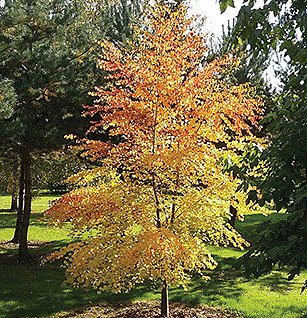
Gardening Journal: Plant of the Month: Cercidiphyllum japonicum
November is the month for leaf colour. If you haven't introduced any trees or shrubs that provide you with that vibrancy of fiery tones then now is the time to start thinking about what you should plant this winter. So many options in all shapes and sizes suitable for gardens of all shapes and sizes too. November is a great time for tree and shrub planting so don’t sit about waiting for winter to pass you by, enjoy the best of the weather before the worst of the winter weather arrives and deal with those little areas you have been meaning to sort out since last year.The Katsura tree, otherwise known as Cercidiphyllum japonicum or the Candyfloss tree, is an upright, gracefully branching tree native to China and Japan and is the only remaining member of the family Cercidiphyllaceae. It gets its name Candyfloss tree from the smell of burnt toffee/sugar that is emitted in the autumn as the leaves start to colour and fall.
Katsuras are dioecious with male and female trees. The flowers appear before the leaves, but lack petals, so they’re of little ornamental interest. The beauty of this tree lies in the broadly oval shape of the tree itself along with the almost heart-shaped leaves that are reddish purple when they emerge, turning green as they mature, and become yellow to scarlet before they fall.
The Katsura tree once ranged over a wide swath of the northern hemisphere. Fossil records have been discovered in both Europe and North America. However now it only grows naturally in China and japan. In Japan, Katsura is an important timber species with the soft, white wood used primarily for cabinetry and panelling.
Ideally Cerciciphyllum like a well drained, fertile soil, avoiding sites that are windy or too hot in the afternoon as the leaves can sometimes scorch. A point to note is that if planted in an alkaline soil its leaves may not colour up so well in the autumn. They Require minimal pruning or maintenance and should be left alone to develop their own shape naturally. However, removal of any broken, diseased or crossing branches in late autumn or winter will help it to mature into a handsome specimen tree.
While cercidiphyllum is a fantastic tree, its not one for the small garden. You need some space and it often looks best in solitude where you can appreciate its form from a distance. It makes a good landscape specimen not only for its form and foliage but also for its relative freedom from insects and disease. Its worth including f you have the space and if you don’t then perhaps its worth a visit to a garden in the autumn that does. Theres nothing quite like that toffee smell drifting through the garden on a beautiful autumn day.
Jobs To Do This Month Include:
Ornamental Garden:
• Part prune roses to prevent windrock.
• Continue to tidy borders if weather permits.
• Final cut for lawns if no frosts.
• Remove fallen leaves.
• Cutback spent foliage and flowers of herbaceous perennials.
• Leave the seedheads of grasses like Miscanthus to provide winter structure.
• Continue to lay turf for new lawns – avoid frosty days if possible.
• Remove surplus dead leaves from ponds.
• Complete planting of bulbs.
• Mulch borders, especially borderline hardy perennials.
• Plant bare root shrubs and roses.
• Prune long stems of roses to avoid windrock.
• Take hard wood cuttings of roses and other deciduous shrubs.
• Scarify lawns.
• Keep off lawns in wet and frosty weather.
Vegetable Garden:
• Begin winter pruning of fruit trees.
• Plant fruit trees, soft fruit and cane fruit.
• Plant garlic cloves.
• Apply grease bands around trunks of fruit trees to protect from winter months.
• Apply a good layer of compost/manure to bare areas of ground.
• Protect salad plants under cloches/fleece etc.
• Clear spent old plants and compost of disease free.

